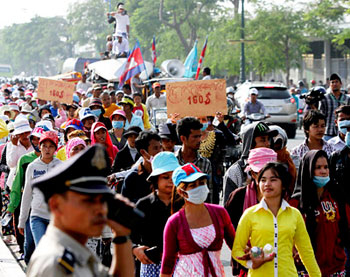

Vol. 78/No. 2 January 20, 2014

|
| Reuters/Samrang Pring |
| Cambodian garment workers launched protest strike Dec. 25 for minimum wage raise to $160 per month. Above, thousands march outside government offices in Phnom Penh, Dec. 31. |
Riot cops and soldiers attacked demonstrators Jan. 3, killing at least four workers and injuring 27. The following day the government banned all protest actions. Protests have since subsided and many workers have returned to the factories for now.
“We demanded a raise of the minimum wage to $160 a month and the government only approved $100,” Say Sokny, secretary-general of the Free Trade Union, said by phone from Phnom Penh Jan. 2. “Workers didn’t agree and immediately went on strike over the whole country. The industry shut down.”
The walkout was touched off by a government announcement that the monthly minimum wage would be raised from $80 to $95, with annual increases to reach $160 by 2018.
On Dec. 27, police fired warning shots and used batons to keep strikers from getting into an industrial park on the outskirts of Phnom Penh where they hoped to encourage fellow workers to join their march. Both cops and strikers were injured in skirmishes.
On Dec. 30 and 31, thousands of workers blocked the streets outside government offices. The government deployed riot police and sealed off buildings with barbed wire.
On Dec. 31 the government raised its minimum wage offer to $100 and ordered strikers to return to work by Jan. 2. “If they continue striking we will cancel their licenses, and if they still continue we will sue them in court,” the Labor Ministry said in a letter to six garment unions.
“The Royal Government and politicians have a role to protect and create an investment climate that is favorable to the investors in the private sector,” the Garment Manufacturers Association said in a statement the same day calling on the government to act.
“This morning nine unions backing the strike held a press conference and gave the government three days to agree to negotiations,” Kong Athit, vice president of the Coalition of Cambodian Apparel Workers Democratic Union, said by phone from Phnom Penh Jan. 2, the day before the cops opened fire.
The Labor Ministry responded with a statement saying that it would not negotiate or offer more than $100 a month.
On Jan. 3, workers in the Canadia Industrial Park confronted cops with rocks, sticks and homemade firebombs. The police first withdrew, then came back with reinforcements and fired into the crowd with AK-47 rifles, according to witnesses. At least four garment workers were killed and 27 injured.
The garment strikes and protests took place in the midst of demonstrations by the Cambodia National Rescue Party, the main opposition party, demanding new elections and Prime Minister Hun Sen’s resignation. Rescue Party leader Sam Rainsy has come out in support of a monthly minimum wage of $160.
In last year’s elections the governing Cambodia People’s Party won 68 seats to the Rescue Party’s 55, a 22-seat loss from 2008. Rainsy accused the government of fraud and boycotted the National Assembly. On Dec. 15 the party launched a campaign of daily protests. Thousands joined the marches and hundreds set up a tent camp in Freedom Park in central Phnom Penh.
On Dec. 22 and 29, more than 100,000 people marched in Rescue Party actions, including garment workers pressing their own demand for $160. As workers swelled the protests, the Rescue Party leadership announced Dec. 29 a weeklong suspension and gave the government until Jan. 5 to consider a proposal for negotiations on election law reforms.
During the weekend of Jan. 4-5, riot police and army units cracked down both on striking workers and Rescue Party protests. The tent camp in Freedom Park was cleared out and all demonstrations and public protests banned.
According to Ken Loo, secretary-general of the Garment Manufacturers Association, 50 to 60 percent of the workers were back to work by Jan. 6.
“We appeal to workers to return to work and earn their wages first, while we decide our next strategy,” Ken Chheanglang, vice president of the National Independent Federation Textile Union of Cambodia, told the Wall Street Journal Jan. 6.
The garment and shoe industry in Cambodia employs 600,000 workers in 800 factories, mostly women from rural areas. The strike wave takes place in the context of rapidly expanding production, a fact not lost to workers who see the opportunity to press for better conditions. During the first 11 months of 2013 garment exports increased 22 percent over the same period in 2012.
Related articles:
Profit drive of oil, rail bosses behind train wreck in ND
On the Picket Line
Boeing Machinists ratify 8-year concession contract
New pattern of struggle developed in partial recovery of ’30s
Only workers can enforce safety
Congress divided over extension of benefits for long-term jobless
Front page (for this issue) |
Home |
Text-version home